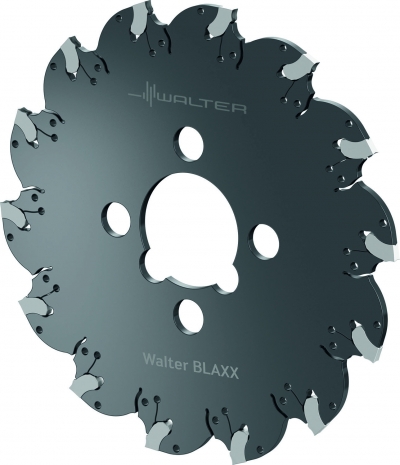
Walter has introduced the Walter BLAXX F5055, a slitting cutter with excellent process reliability, accuracy and tool life. It teams the extremely robust and precise construction of Walter BLAXX with the Walter Cut SX system of inserts. Based on self-gripping, form-locking indexable inserts and directing the cutting force into the tool, the Walter Cut SX system helps give the Walter BLAXX F5055 slitting cutter its superior process reliability with safe clamping of the insert even at higher speeds.
Indexable inserts for the F5055 are available in a variety of grades and chip breakers to allow applications in a wide range of materials. The SF5 geometry in either grade WSM33S (harder) or WSM43S (tougher) is the primary choice for slot milling applications. Or, if machining aluminum, the SK8 geometry, in the uncoated WK1 grade, is also offered.
The Walter Cut SX grooving system and the F5055 use the same indexable inserts, so users benefit from reduced inventory costs and additional grades and geometries. Walter supplies the F5055 in diameters of 63 to 500 mm for insert widths and cutting widths of 1.5 to 5.0 mm.
Drive collars are available for arbor-mounting configurations, but adaptors for either ScrewFit or shell mill-mount configurations in both inch and metric pilot dimensions, are also available.
The tool is suitable for cast-iron, steel and stainless-steel components. In addition, it also handles materials with difficult cutting properties such as in the aerospace industry, where production of large volumes of the highest-quality components demands tools with exceptional reliability.
Contact Details
Related Glossary Terms
- cutting force
cutting force
Engagement of a tool’s cutting edge with a workpiece generates a cutting force. Such a cutting force combines tangential, feed and radial forces, which can be measured by a dynamometer. Of the three cutting force components, tangential force is the greatest. Tangential force generates torque and accounts for more than 95 percent of the machining power. See dynamometer.
- gang cutting ( milling)
gang cutting ( milling)
Machining with several cutters mounted on a single arbor, generally for simultaneous cutting.
- gang cutting ( milling)2
gang cutting ( milling)
Machining with several cutters mounted on a single arbor, generally for simultaneous cutting.
- grooving
grooving
Machining grooves and shallow channels. Example: grooving ball-bearing raceways. Typically performed by tools that are capable of light cuts at high feed rates. Imparts high-quality finish.
- milling
milling
Machining operation in which metal or other material is removed by applying power to a rotating cutter. In vertical milling, the cutting tool is mounted vertically on the spindle. In horizontal milling, the cutting tool is mounted horizontally, either directly on the spindle or on an arbor. Horizontal milling is further broken down into conventional milling, where the cutter rotates opposite the direction of feed, or “up” into the workpiece; and climb milling, where the cutter rotates in the direction of feed, or “down” into the workpiece. Milling operations include plane or surface milling, endmilling, facemilling, angle milling, form milling and profiling.







